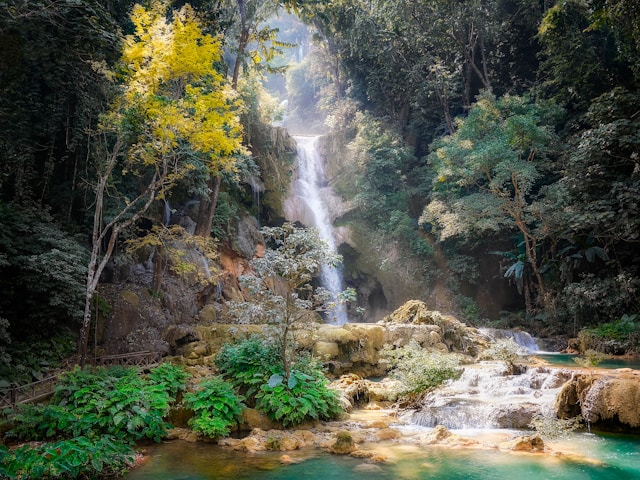Esteros de Iberá, one of Argentina’s most precious ecological treasures, is a vast wetlands area that has been captivating nature lovers, adventurers, and conservationists for years. Located in the northeast of Argentina, this vast region is home to a rich diversity of wildlife and ecosystems, including marshes, lagoons, and rivers, offering a unique glimpse into the world of South American biodiversity. Whether you’re a seasoned traveler or simply an environmental enthusiast, these 10 fascinating facts about Esteros de Iberá will leave you in awe of its natural beauty and ecological importance.
1. A Hidden Ecological Gem in Argentina
- Esteros de Iberá is Argentina’s second-largest wetland and covers an expansive 13,000 square kilometers. The region is located in the Corrientes province, stretching across the Argentine Pampas into the subtropical forests. The Iberá Wetlands have remained relatively hidden compared to other famous global wetlands, but their ecological significance is undeniable.
- Unlike the well-known Pantanal of Brazil, Esteros de Iberá is far less explored, which makes it an ideal destination for those seeking an off-the-beaten-path adventure. This hidden gem is increasingly recognized for its role in preserving unique ecosystems and biodiversity.
2. Home to Rare and Endangered Species
- Esteros de Iberá is a critical habitat for a variety of endangered and rare species. Notably, the wetlands are home to the iconic Pampas deer, the giant river otter, and the yacaré caiman. The region’s diverse habitats, which include forests, marshes, and waterways, support a wide array of wildlife.
- One of the standout species is the capybara, the world’s largest rodent, which roams the area in large colonies. The Esteros are also known for hosting a significant population of the elusive jaguar, an apex predator that is often difficult to spot but plays a crucial role in the region’s ecosystem.
3. A Birdwatcher’s Paradise
- Birdwatching is one of the most popular activities in Esteros de Iberá. With over 350 bird species recorded, the area offers a prime location for bird enthusiasts. Among the most notable birds is the endangered red-and-green macaw, which can be spotted flying through the wetlands, adding a burst of color to the already vibrant landscape.
- Other notable bird species include the greater rhea, the black-necked swan, and the American flamingo. The wetlands’ diverse habitats provide ideal conditions for both migratory and resident bird populations, making it a prime destination for birdwatching year-round.
4. The Largest Freshwater Reserve in Argentina
- Iberá’s wetlands are part of the Paraná River Basin, and its waters form one of the largest freshwater reserves in Argentina. This vast network of rivers, streams, and lakes plays a significant role in the local water cycle, serving as a crucial source of water for the surrounding communities.
- The wetlands act as natural filters for the water, improving water quality and sustaining the rich biodiversity of the area. Due to its role in water purification and regulation, Iberá is often referred to as the “lungs of the region.”
5. A Key Site for Ecotourism and Sustainable Travel
- Over the last few decades, Esteros de Iberá has gained recognition as a hub for ecotourism. Local organizations, such as the Iberá Foundation, have worked tirelessly to promote sustainable tourism and raise awareness about the importance of preserving this unique ecosystem.
- Visitors to the region can explore the wetlands through a variety of activities, such as boat tours, kayaking, hiking, and wildlife watching. The community has embraced responsible tourism, with accommodations and services designed to minimize environmental impact and promote local economic development.
6. A Crucial Conservation Effort: The Reintroduction of Jaguars
- One of the most inspiring stories from Esteros de Iberá is the ongoing conservation effort to reintroduce jaguars to their natural habitat. Jaguars once roamed freely throughout the Iberá wetlands but became extinct in the region during the 20th century due to habitat loss and poaching.
- Thanks to the efforts of conservationists and local communities, a program has been underway since 2015 to bring these magnificent big cats back to the wetlands. Jaguars have been reintroduced to the wild, and their populations are steadily increasing, marking a huge success in the region’s conservation efforts.
7. A Complex and Diverse Ecosystem
- The ecosystem of Esteros de Iberá is incredibly complex and diverse, providing a range of habitats from wetland marshes to dense forests. The different zones support a multitude of species, many of which rely on specific microhabitats to survive.
- The region includes vast marshes that flood seasonally, creating an ever-changing environment that shapes the lives of the plants and animals that call it home. There are also dryland areas and forests, offering habitats for a variety of flora and fauna. This biodiversity is one of the reasons why Esteros de Iberá is considered a globally important ecological site.
8. The Rich Flora of Iberá Wetlands
- While most visitors come for the wildlife, the flora of Esteros de Iberá is equally impressive. The wetlands are home to numerous aquatic plants, such as reeds, grasses, and water lilies, that not only add to the natural beauty but also provide crucial habitats for many species of birds and insects.
- In the forests surrounding the wetlands, you’ll find trees such as the carob, quebracho, and eucalyptus, which help sustain the local ecosystem by providing food and shelter for wildlife. These plants also help protect the wetlands from erosion by stabilizing the soil.
9. Cultural Significance of Iberá
- The people of the Corrientes province, particularly the Guaraní communities, have a deep cultural connection to the Iberá Wetlands. For centuries, these communities have relied on the wetlands for resources, such as fish and medicinal plants, and have developed a wealth of traditional knowledge about the ecosystem.
- Today, these communities continue to play an integral role in the conservation and management of the region, sharing their insights with visitors and working alongside conservation organizations to protect the land.
10. Accessible by Eco-friendly Tours and Activities
- Esteros de Iberá has been developed with ecotourism in mind, ensuring that visitors can experience its beauty while minimizing their environmental impact. There are several eco-friendly tour options available, such as electric boat rides, guided nature walks, and cycling tours. These activities allow tourists to explore the wetlands’ diverse landscapes without disturbing the delicate ecosystem.
- The focus on eco-tourism also includes efforts to reduce waste and encourage sustainable practices among both tourists and locals. Visitors can enjoy an authentic experience of the wetlands while supporting the preservation of this important natural area.
Conclusion
Esteros de Iberá is not only one of Argentina’s most remarkable natural wonders but also a symbol of what can be achieved through conservation and sustainable tourism. Its rich biodiversity, stunning landscapes, and successful reintroduction programs have earned it a place among the world’s most important ecological hotspots. Whether you’re an avid wildlife photographer, an ecotourism enthusiast, or simply someone looking to connect with nature, Esteros de Iberá offers an unforgettable experience.
FAQs
1. What is Esteros de Iberá?
Esteros de Iberá is a vast wetland ecosystem located in northeastern Argentina, covering approximately 13,000 square kilometers. It is one of the largest wetlands in Argentina and a key site for biodiversity conservation.
2. Can I visit Esteros de Iberá?
Yes, Esteros de Iberá is open to visitors, with a variety of eco-friendly tour options available, including boat rides, hiking, and birdwatching tours. The area is becoming increasingly popular with ecotourists looking for sustainable travel options.
3. What animals can I see in Esteros de Iberá?
Esteros de Iberá is home to a variety of species, including the capybara, giant river otter, Pampas deer, yacaré caiman, and over 350 bird species, such as the red-and-green macaw and the greater rhea.
4. Why is Esteros de Iberá important for conservation?
Esteros de Iberá is a critical habitat for endangered species, provides important ecological services such as water filtration, and serves as a natural buffer against climate change. The successful reintroduction of jaguars is one of the region’s most significant conservation efforts.
5. How can I get to Esteros de Iberá?
Esteros de Iberá is accessible by road from the city of Corrientes or Mercedes. Visitors can also book tours through local agencies that offer transportation and eco-friendly excursions.
Also read : Pandan Gula Melaka Cake: A Sweet Twist on Traditional Flavors




Leave a Comment